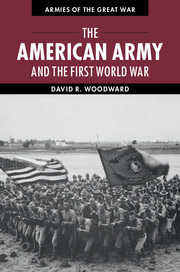Book contents
- Frontmatter
- Dedication
- Contents
- List of figures
- List of maps
- List of tables
- Preface
- List of abbreviations
- Introduction
- 1 Birth of a modern army
- 2 World war and American preparedness
- 3 Coercive power and Wilsonian diplomacy
- 4 “You’re in the army now”
- 5 US army doctrine and industrialized trench warfare
- 6 Over where?
- 7 American Expeditionary Force organization, overseas training, and deployment
- 8 Will the Americans arrive in time?
- 9 Failed expectations: “the military establishment of the United States has fallen down”
- 10 Atlantic ferry
- 11 Neck of the bottle
- 12 Uncertain times
- 13 Cantigny
- 14 Into the breach
- 15 American soldiers in north Russia and Siberia
- 16 The beginning of the end
- 17 Establishment of the American First Army and Saint-Mihiel
- 18 Meuse-Argonne, September 26–October 31
- 19 Breakout, November 1–11
- 20 Epilogue
- Notes
- Bibliography
- Index
15 - American soldiers in north Russia and Siberia
Published online by Cambridge University Press: 05 July 2014
- Frontmatter
- Dedication
- Contents
- List of figures
- List of maps
- List of tables
- Preface
- List of abbreviations
- Introduction
- 1 Birth of a modern army
- 2 World war and American preparedness
- 3 Coercive power and Wilsonian diplomacy
- 4 “You’re in the army now”
- 5 US army doctrine and industrialized trench warfare
- 6 Over where?
- 7 American Expeditionary Force organization, overseas training, and deployment
- 8 Will the Americans arrive in time?
- 9 Failed expectations: “the military establishment of the United States has fallen down”
- 10 Atlantic ferry
- 11 Neck of the bottle
- 12 Uncertain times
- 13 Cantigny
- 14 Into the breach
- 15 American soldiers in north Russia and Siberia
- 16 The beginning of the end
- 17 Establishment of the American First Army and Saint-Mihiel
- 18 Meuse-Argonne, September 26–October 31
- 19 Breakout, November 1–11
- 20 Epilogue
- Notes
- Bibliography
- Index
Summary
On May 14, 1918 a trainload of Hungarian soldiers drew up alongside a train packed with Czecho-Slovak soldiers at the railway station at Chelyabinsk, Russia. Called the doorstep to Siberia, Chelyabinsk stood in the southern part of European Russia where Europe borders with Asia. The Hungarians, formerly POWs being held in Siberia, were being repatriated to Austria–Hungary. Czecho-Slovak soldiers were headed in the opposite direction, to Russia’s primary port on the Pacific Ocean, Vladivostok, a six-day or 8,300-kilometer train ride along the famous Trans-Siberian Railway.
Following the outbreak of war the Russian Army created a small detachment composed of Czechs and Slovaks then dwelling in the Russian Empire. The democratic Provisional Government that followed the demise of the Romanovs expanded considerably this detachment by including Czech and Slovak POWs. Now the size of an army corps, and fighting for the creation of an independent Czecho-Slovak state, the so-called Czech Legion accepted the general direction of the French Supreme Command which originally viewed this disciplined military force, numbering some 60,000 men, as reinforcements for the Western Front. The British War Office, however, hoped to use this force as a nucleus around which a pro-Allied force might be organized in Siberia. With their future in limbo, the Czechs at Chelyabinsk and elsewhere were aboard trains heading east, perhaps to be transported to France if shipping were available at Vladivostok, or perhaps to be used by the Allies to control the strategic Trans-Siberian Railway.
- Type
- Chapter
- Information
- The American Army and the First World War , pp. 256 - 275Publisher: Cambridge University PressPrint publication year: 2014



